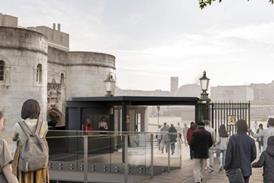The ready availability of concrete and steel seems to have discouraged us from experimenting with new possibilities, says Anna Beckett

For almost a century we have designed buildings using four structural materials: steel, concrete, timber and masonry. There have been some developments – we’ve regulated steel section sizes and grades, developed precast concrete and created engineered timber products such as glulam and CLT – but the structural elements of most buildings are made of one of those four materials. We actually use concrete so much that it is now the second-most abundant substance on earth; the only thing we have more of is water.
What is it about these four materials that makes them so great? And, with huge technological advances in other sectors, what’s stopping us from developing greener, more efficient options?

Concrete clearly is an incredibly useful material. It’s cheap, easy to make and use, and widely understood. It works well in compression and, when properly maintained, has a relatively long life. But are we using concrete because it’s the most suitable material, or are we designing our buildings to suit a concrete structure because it’s cheap and easy? If the latter, could we be using other materials instead?
One of the main barriers to using less conventional materials is regulation. For a structural engineer, the easiest way to justify that your structure is suitably well designed is to design it to the Eurocodes, and the materials covered most thoroughly are steel, concrete, timber and masonry. Should you deviate from these, justifying your structure to building control and insurance providers becomes more difficult. Even widely used materials such as stone require more thorough testing and justification, and you often have to relate them to the standards for other materials – for example, a stone structure might meet parts of the masonry code as well as parts of cladding codes.
Even reasonably simple materials can be difficult to justify, but with testing and an open-minded contractor there are many low-tech, low-carbon natural construction options which should be considered. On a site with the right ground conditions, rammed earth walls could act as a load-bearing structure, if you’re prepared to alter the architectural layout to allow for a different kind of construction. Straw bales, or bales made from a variety of other recycled materials, can also be used as a structural element, while also helping to insulate the building. Cork blocks, made from reconstituted waste cork, can be used as a lightweight structural alternative, offering good resistance to fire, water and rot.

If we look to more high-tech materials, glass reinforced plastic (GRP) and carbon fibre can both be used structurally. Other industries have made use of these materials with great success and there are some examples of them being used in construction. Carbon fibre has significantly higher strength than steel while being considerably lighter, making it ideal for smaller structural uses where the weight is important (such as bikes). When considering it as a construction material, however, its significantly higher cost is usually prohibitive – using it in combination with another material or in a situation where the weight is important could be an option instead. GRP panels have been used successfully in high-performance situations, particularly as it can carry high tensile loads and is a completely inert and non-conductive material. Both GRP and CRP (carbon reinforced plastic) are already used for complex shaped cladding panels.
If we allow our building forms to be led by the materials, perhaps we could combine the low-tech and high-tech in more unusual combinations to make the best of their structural properties. We could create 3D printed CRP columns and arches supporting rammed earth vaults, or a load-bearing wall formed from cob reinforced with plastic fibres. The possibilities are endless once we get comfortable with a wider range of materials.
Or maybe there’s another material out there that we haven’t discovered yet. With concrete and steel so readily available, and relatively little consideration of the environmental impacts of producing these materials, perhaps the issue is that we’ve stopped trying to find something better. New materials will always be more difficult and more expensive to use, but the more widespread they are, the cheaper and better understood they become. We cannot and should not continue to build in concrete just because it’s easy – our planet simply can’t support it. We have to find ways to use other materials that have less of an impact, even if it’s more difficult.
Postscript
Anna Beckett is an associate at Webb Yates Engineers
















No comments yet